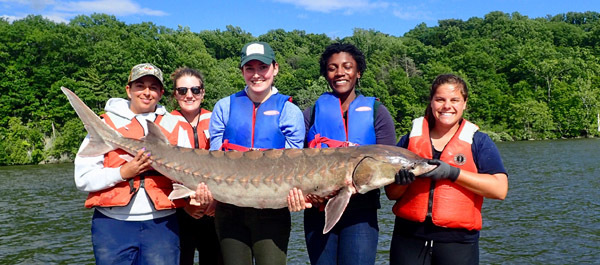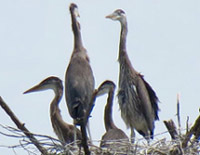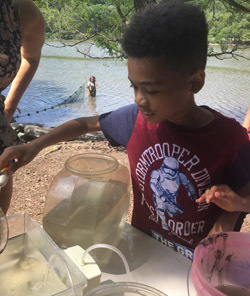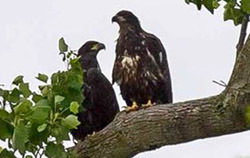Hudson River Almanac 6/02/18 - 6/08/18
The New York State Department of Environmental Conservation sent this bulletin on 06/15/2018 02:00 PM EDT |
| DEC Delivers - Information to keep you connected and informed from the NYS Department of Environmental Conservation |
| Share or view as a web page || Update preferences or unsubscribe |
|
|
OVERVIEW This was the week of the 4th annual Great Fish Count, a hands-on celebration of the marine life at 17 sites in the waters surrounding the five boroughs of New York City. It provided a unique experience for many participants to view the incredible diversity of marine life in our estuary. In the uplands, we had our first bald eagle nestlings-to-fledglings as young eagles took their first flight. 6/4 – Dutchess County, HRM 85: The NYSDEC Hudson River Fisheries Unit caught a 7½-foot Atlantic sturgeon today. She was a female with eggs (caviar) and had recently migrated in from the sea. Both Atlantic and shortnose sturgeon are federally endangered species. In the 20th century, they were simply regarded as commodities to be exploited until their populations plummeted. As a result of conservation efforts, their stocks are rebounding. The sturgeon was collected, photographed, tagged, and released under Federal Permit 20340. [Sturgeon are the stuff of myth and legend. In terms of evolution, they are a very ancient class of cartilaginous (non-bony) fishes whose ancestry dates back several hundred million years. Among their many unusual behavioral traits is their predilection for jumping clear out of the water similar to the breaching behavior of dolphins and whales. There are Hudson River records of sturgeon leaping and landing in canoes and fishing boats. While drift-netting for American shad twenty years ago, Chris Lake and I had a five-footer leap, land on the gunnel of our boat, teeter, and then topple back into the river. Why they leap is a mystery. It may be a way to take in air to fill their swim bladder. Biologists are unsure. Tom Lake] NATURAL HISTORY ENTRIES [Note: Last week in the Almanac, we labeled a butterfly photo as a monarch (Danaus plexippus) when, in fact, it was a viceroy (Limenitis archippus). Don Miller, among other readers, pointed this out. There is much irony in this mislabeling; the Viceroy is a mimic of the monarch, an adaptation in color and design that scientists believe is an inherent predator avoidance strategy. (Monarchs are thought to be poisonous from their diet of milkweed.) The irony lives in the fact that the viceroy fooled us as well. Tom Lake] 6/2 – Rensselaer County, HRM 168: It looks like there are two nestlings in bald eagle nest NY334A that overlooks the Hudson River at the Route 67 bridge connecting Mechanicville and Schaghticoke.
6/2 – Hudson River Estuary: We held our 4th annual Great Fish Count today at 17 sites, adding three new species to the Fish Count bringing the total to 31: feather blenny (Hypsoblennius hentz), Atlantic herring (Clupea harengus), and spot (Leiostomus xanthurus). The top catch for 2018 was striped killifish (217) with mummichogs a close second (190). 6/2 – Alpine, HRM 18: The Alpine Boat basin is a half-tide beach for seining: At high tide there is no beach; at low tide you are faced with sucking mud flats. Three-dozen participants were on hand to watch and help us sample the Hudson River for the Great Fish Count. Our effort was earnest, but our results were mixed. Across 15 hauls of our seine, we caught a dozen fish, including young-of-the-year (YOY) Atlantic menhaden, (35-38 millimeters (mm)), and Atlantic tomcod (40-48 mm), as well as bay anchovy and white perch. Mixed in with the fish were small blue crabs and shore shrimp. The salinity was 6.0 parts-per-thousand (ppt) and the water temperature was 73 degrees Fahrenheit (F). [Note: one inch = 25.4 millimeters (mm)] 6/2 – Yonkers, HRM 18: We held our River Explorers seining program this afternoon for the Great Fish Count at the Sarah Lawrence College Center for the Urban River at Beczak with students ranging from 5-12 years-old. They were excited about Hudson River ecology, and it did not matter that our catch was mediocre. Among the fish were white perch and American eels, topped off by five fascinating blue crabs!
6/2 – Manhattan, HRM 1: For the Great Fish Count, we checked our research sampling gear in Hudson River Park at The River Project's sampling station on the lighthouse tender Lilac at Pier 25. Our catch was impressively large and diverse! In addition to two amazing (68, 85 mm) lined sea horses (Hippocampus erectus), we caught two tautog (185, 295 mm), and a large oyster toadfish (250 mm). 6/2 – Manhattan, New York City: Randall's Island, situated at the intersection of the Harlem River and the East River, hosted the Great Fish Count along with 50 participants. Our seine captured YOY Atlantic tomcod and bluefish, northern pipefish, a bay anchovy, and a new species to the Great Fish Count, a YOY Atlantic herring (50 mm). Salinity was 23.0 ppt and the water temperature was 63 F. [Atlantic herring (Clupea harengus) are one of eight members of the herring family (Clupeidae) that includes, among others, American shad, blueback herring, alewife, and Atlantic menhaden. C. Lavett Smith’s Inland Fishes (1980) cites their occurrence in the estuary as very much a sometimes event having been found on occasion as far upriver as Indian Point. Tom Lake] 6/2 – Brooklyn, New York City: Bush Terminal, a reclaimed industrial site in a fairly urban area, provided the forum for today’s Great Fish Count. The seining team, with 79 onlookers, pulled in a net full of fish. Among them were mummichogs, YOY winter flounder, Atlantic silverside, northern pipefish, and a new fish to the Great Fish Count, a feathered blenny. The salinity was 20 ppt and the water temperature was a warm 79 F. [Feather blenny (Hypsoblennius hentz), a seasonally marine resident, is a small, scale-less fish with fleshy cirri “feathers” on their head. Their lower jaw has a row of small, close-set teeth like those of a comb, thus their family name, combtooth blennies (Blenniidae). Blennies are benthic dwellers where they often burrow in the soft bottom or find refuge in old mollusk shells. The first documented feather blenny for the Hudson River list was caught by the Manhattan River Project in 1994. C. Lavett Smith] 6/2 – Queens, New York City: Fort Totten was a new site for the 2018 Great Fish Count and hosted nearly 200 attendees. Our seine collected eight species of fish, among them YOY Atlantic tomcod, a lined seahorse, northern pipefish, a summer flounder, YOY Atlantic herring (43 mm), and a new species to the Great Fish Count, a YOY spot. The salinity was a salty 24 ppt and the water temperature was 69 F. [Spot (Leiostomus xanthurus) are a sporadic visitor to the Hudson estuary. Their colloquial name, “Lafayette,” honors France’s Marquis de Lafayette. His visit to New York City in 1824, to be honored for his role in the American Revolution on behalf of the American Colonies, coincided with unusually large numbers of these palm-sized fish in New York Harbor. Spot are a member of the drum family of fishes that also includes freshwater drum, black drum, northern kingfish, croakers, weakfish, and silver perch. Most of them have highly specialized swim bladders that serve as sound-producing organs. This has led to the colloquial family name of “drum.” Tom Lake] 6/2 – Queens, New York City: Frank Charles Park, one of the most southern sites for our Great Fish Count, routinely produces large numbers of salt-loving striped killifish (Fundulus majalis). This year's seining did not disappoint our 38 participants as we captured 216 striped killifish, by far the most prominent fish in our net. Among the other fishes were mummichogs, Atlantic silverside, and summer flounder. 6/3 – Beacon, HRM 61: There were good numbers of relatively small fish today, including three carp and three channel catfish. The largest carp was 6.0 pounds. The carp spawn hadn't started yet at Beacon, but one could sense it was imminent. The spring striped bass recreational fishery seemed to be over; there were no boats drifting the river. 6/3 – Staten Island, New York City: We went back to our local beach today, overlooking the Lower Bay of New York Harbor, and saw the killdeer nest that we came across in April. There was one chick from a clutch of four eggs. With the number of feral cats, raccoons, and opossums we have, it is a miracle to see even that one chick. We went the opposite way on the trail today and came across another killdeer with a clutch of eggs.
6/5 – Town of Poughkeepsie: There was much drama on Day 73 for the two nestlings at bald eagle nest NY62. While one nestling was still visible settled in the nest, the second one was missing. Drama became anxiety as we assumed that either a fledge had occurred or the other nestling had fallen from the tree. As darkness fell, we were still unable to locate the nestling. 6/5 – Yonkers, HRM 18: Greenville School’s 4th grade class joined us today at the Sarah Lawrence Center for the Urban River at Beczak. The tides this week were not favorable – generally too high – but the 19 students were excited to put on waders and help us seine the river, regardless of the tide. We cautioned them that our net might come up empty, so when we caught a gorgeous little bay anchovy and an equally interesting shore shrimp, they were very pleased. 6/6 – Town of Poughkeepsie: It was Day 74 at bald eagle nest NY62. For the first hour of our search, we were still unable to locate the missing nestling. Then we found it, far down in the nest tree, partially obscured by foliage. Before long, the nestling scrambled back up into the nest to join its sibling. 6/6 – Yonkers, HRM 18: Twenty-eight 5th grade students from School 16 in Yonkers came to the Sarah Lawrence Center for the Urban River at Beczak today to help us sample the Hudson River. The tide was again not cooperating, and after catching nothing for six hauls of our seine, we decided to take a smaller net into the Beczak marsh where we found blue crabs, white perch, and mummichogs. 6/7 –- Hadley, HRM 208: I checked on bald eagle nest NY184 today at Stewarts Bridge Reservoir, an impoundment of the Sacandaga River below the Conklingville Dam that eventually runs into the Hudson River. On a previous visit, I did not see any activity. Today (surprise!) I saw at least one nestling. 6/7 –- Norrie Point, HRM 85: This year's single nestling in bald eagle nest NY142 in Ulster County had fledged. This was the earliest fledge I have seen in 12 years of watching several eagle nests. But it was not totally unexpected as this nest also had the earliest start to incubation, February 1. The new fledgling was seen today perched in a sycamore along the Indian Kill clutching a catfish with one of the adults watching nearby.
[Gynandromorphism describes an organism that displays both male and female characteristics. The term gynandromorph is from the Greek “gyne” = female and “andros” = male. While it is rare, it is not unknown. Tom Lake] 6/7 – Town of Poughkeepsie: It was now Day 75 at bald eagle nest NY62 and the more “ready” of the two nestlings had fledged. Or so we thought. The adventurous nestling that had returned to the nest yesterday was now alone, perched high in the nest tree, and its eager sibling was gone. [In the previous 17 years at bald eagle nest NY62, we knew the exact day, if not the hour and the minute, when the nestlings became fledglings. Despite the best efforts of our dedicated monitors (The Soul of NY62), the dates this year would prove to be a bit problematic. Tom Lake] 6/7 –- Croton-on-Hudson, HRM 34.5: I spotted a juvenile (possibly still a nestling) osprey perched on the cell phone tower at the Croton train station yesterday. An adult osprey flew in to the tower and landed. The young osprey jumped into the nest as well, and it appeared the adult had brought some food. I have found many fish scraps under the cell tower that were too small or ragged to identify. This morning, the juvenile osprey was once again perched on the cell tower and calling for food. 6/7 –- Wappinger Creek, HRM 67.5: The “crashing splashes” had begun. Spawning carp will put on a show in shallow tidewater all along the estuary for the next month. To the uninitiated, they may seem like unidentified fish objects (UFOs) as they breach the surface, often hovering briefly in the air, before crashing back into the water. If you only hear them, it will sound as though someone is tossing huge rocks into the water. Dedicated carp anglers, like Bill Greene, will do battle with fish that commonly run to 25 pounds or more in the river. 6/8 – Town of Poughkeepsie: This morning was so exciting! It was now Day 76 at bald eagle nest NY62, and the second nestling had made its first flight. I spotted the new fledging as it was coming back to the nest tree from a brief tour of the area. [We like to think of bald eagle nest NY62 as a good representation of the other eagle nests in the Hudson River watershed, especially those that we are unable to faithfully monitor. With these two nestlings, the female in NY62 had now fledged 18 nestlings in 18 years, from three different nests. Tom Lake]
[In the late 1970s, recreational fishing for tomcod (Microgadus tomcod) was a popular winter activity in the lower Hudson River. Catches were routinely made between Thanksgiving and Saint Patrick’s Day from Bear Mountain downriver to Manhattan. During the season, a tavern on Old Steamboat Dock in Verplanck served delicious fried tomcod with your beer. Tom Lake] 6/8 – Yonkers, HRM 18: This was the final day for three of our interns at the Sarah Lawrence Center for the Urban River at Beczak so we went seining! The catch was small, but interesting and varied, and included bay anchovies, blue crabs, and shore shrimp. 6/8 – Manhattan, HRM 1: We checked our research sampling gear in Hudson River Park at The River Project's sampling station on the lighthouse tender Lilac at Pier 25. In one crab pot was an absolutely massive tautog (390 mm; 16-inches). There was also a female blue crab in the pot. The highlight, however, was an adorable feather blenny (80 mm). [The design and function of a crab pot, much like a lobster pot, is very old. For more than a hundred years, we have been unable to create a simpler or more efficient collection device. The average “overnight” crab pot is a cube, measuring 22-inches on a side, with two seven-inch portals that taper to four inches inside the pot. In today’s example at Pier 25, the blackfish found its way into the pot through one of the portals to feed on the trapped blue crabs, but then could not find its way out. Tom Lake]
Free Trees for Streamside Planting For more information about the program or to download an application, please visit the DEC website at: www.dec.ny.gov/lands/43668.html . If you have questions about a potential planting site, please contact Beth Roessler at (845) 256-2253 or HudsonEstuaryTFT@dec.ny.gov. The Hudson is measured north from Hudson River Mile 0 at the Battery at the southern tip of Manhattan. The George Washington Bridge is at HRM 12, the Tappan Zee 28, Bear Mountain 47, Beacon-Newburgh 62, Mid-Hudson 75, Kingston-Rhinecliff 95, Rip Van Winkle 114, and the Federal Dam at Troy, the head of tidewater, at 153. The tidal section of the Hudson constitutes a bit less than half the total distance – 315 miles – from Lake Tear of the Clouds to the Battery. Entries from points east and west in the watershed reference the corresponding river mile on the mainstem. TO CONTRIBUTE YOUR OBSERVATIONS OR TO SUBSCRIBE The Hudson River Almanac is compiled and edited by Tom Lake and emailed weekly by DEC's Hudson River Estuary Program. Share your observations by e-mailing them to trlake7@aol.com. To subscribe to the Almanac (or to unsubscribe), use the links on DEC's Hudson River Almanac or DEC Delivers web pages. Discover New York State Conservationist - the award-winning, advertisement-free magazine focusing on New York State's great outdoors and natural resources. Conservationist features stunning photography, informative articles and around-the-state coverage. Visit the Conservationist webpage for more information. USEFUL LINKS National Oceanic and Atmospheric Administration online tide and tidal current predictions are invaluable when planning Hudson River field trips. For real-time information on Hudson River tides, weather and water conditions from sixteen monitoring stations, visit the Hudson River Environmental Conditions Observing System website. NY Open for Hunting and Fishing Initiative: Under Governor Cuomo's Adventure NY initiative, DEC is making strategic investments to expand access to healthy, active outdoor recreation, connect more New Yorkers and visitors to nature and the outdoors, protect natural resources, and boost local economies. This initiative will support the completion of more than 75 projects over the next three years, ranging from improvements to youth camps and environmental education centers to new boat launches, duck blinds, and hiking trails. Read more about the Adventure NY initiative. For more information on planning an outdoor adventure in New York State, visit DEC's website at http://www.dec.ny.gov/outdoor. Information about the Hudson River Estuary Program is available on DEC's website at http://www.dec.ny.gov/lands/4920.html. Copies of past issues of the Hudson River Almanac, Volumes II-VIII, are available for purchase from the publisher, Purple Mountain Press, (800) 325-2665, or email purple@catskill.net |

 Hudson River Almanac
Hudson River Almanac 6/2 – Bedford, HRM 35: The nestlings at the great blue heron rookery were growing rapidly and appeared to be well fed. Their feathers were growing out, and several were seen exercising their wings. Their tail feathers had not grown out yet, and they now looked half the size of the adults. It was a warm day, and they were panting to cool off while they waited for their next meal to arrive. (Photo of great blue herons courtesy of Jim Steck)
6/2 – Bedford, HRM 35: The nestlings at the great blue heron rookery were growing rapidly and appeared to be well fed. Their feathers were growing out, and several were seen exercising their wings. Their tail feathers had not grown out yet, and they now looked half the size of the adults. It was a warm day, and they were panting to cool off while they waited for their next meal to arrive. (Photo of great blue herons courtesy of Jim Steck) 6/2 – Manhattan, HRM 13.5: Students from Dinorah Hudson’s Advanced Placement science class helped us seine at Inwood Park for the Great Fish Count. In addition to many blue crabs of all sizes, were six species of fish, including Atlantic silverside, bay anchovy, summer flounder, winter flounder, mummichogs, and white perch, including one that was a foot-long! (Photo of Great Fish Count at Inwood Park courtesy of Rebecca Houser)
6/2 – Manhattan, HRM 13.5: Students from Dinorah Hudson’s Advanced Placement science class helped us seine at Inwood Park for the Great Fish Count. In addition to many blue crabs of all sizes, were six species of fish, including Atlantic silverside, bay anchovy, summer flounder, winter flounder, mummichogs, and white perch, including one that was a foot-long! (Photo of Great Fish Count at Inwood Park courtesy of Rebecca Houser) 6/4 – Town of Poughkeepsie: The two nestlings in bald eagle nest NY62 were now 72 days old and looked ready to go. They were at the edge of the average fledge date for Northeast U.S. bald eagles (72-90 days). Nestlings from bald eagle nest NY62, across 17 years, have fledged on average in 79 days. (Photo of bald eagle nestlings courtesy of Bob Rightmyer)
6/4 – Town of Poughkeepsie: The two nestlings in bald eagle nest NY62 were now 72 days old and looked ready to go. They were at the edge of the average fledge date for Northeast U.S. bald eagles (72-90 days). Nestlings from bald eagle nest NY62, across 17 years, have fledged on average in 79 days. (Photo of bald eagle nestlings courtesy of Bob Rightmyer) 6/7 – Town of Poughkeepsie, HRM 70: The gynandromorphous (genetically part male and part female) rose-breasted grosbeak I saw last May was back. I'm glad to see it was still seeming healthy and thriving, since some creatures with genetic anomalies have health issues. (Photo of rose-breasted grosbeak courtesy of Diane P. DesAutels)
6/7 – Town of Poughkeepsie, HRM 70: The gynandromorphous (genetically part male and part female) rose-breasted grosbeak I saw last May was back. I'm glad to see it was still seeming healthy and thriving, since some creatures with genetic anomalies have health issues. (Photo of rose-breasted grosbeak courtesy of Diane P. DesAutels) 6/8 – Beacon, HRM 61: In the wake of several cool nights, the river temperature had dropped to 71 F. A strong south wind was piling swells up on the beach making seining a challenge. Consequently, our expectations were limited. We had begun to think we would get shut out when, in the final haul of our short seine, we landed four YOY Atlantic tomcod (51-67 mm). (Photo of atlantic tomcod courtesy of Tom Lake)
6/8 – Beacon, HRM 61: In the wake of several cool nights, the river temperature had dropped to 71 F. A strong south wind was piling swells up on the beach making seining a challenge. Consequently, our expectations were limited. We had begun to think we would get shut out when, in the final haul of our short seine, we landed four YOY Atlantic tomcod (51-67 mm). (Photo of atlantic tomcod courtesy of Tom Lake)